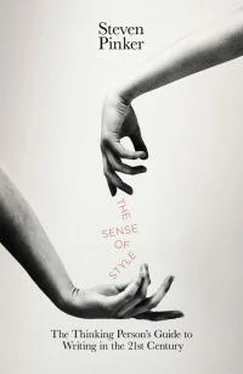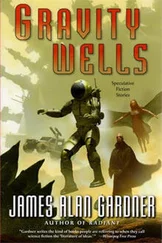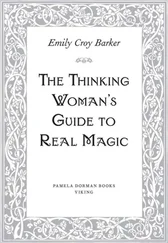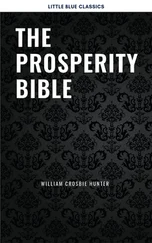Writers often resist telegraphing their point at the outset. Sometimes they feel it would spoil the suspense. Sometimes they are victims of professional narcissism and write as if the reader were interested in every blind alley, fool’s errand, and wild-goose chase they engaged in while exploring the topic. Most often, they themselves don’t know the point of their essay until they have written a first draft, and never go back to reshape the essay so that the point is clear at the beginning. An old cartoon captioned “The PhD thesis” shows a little boy firing an arrow into the air, seeing where it lands, walking over to it, and painting a target around that spot. It’s not how science should work, but it’s sometimes how writing must work.
Some genres, such as the scholarly journal article, force an author to lay out her point in a summary, an abstract, or a synopsis. Others, such as magazines and newspapers, help the reader with a tag line (an explanation beneath the cutesy title) or a pull quote (an illustrative sentence displayed in a box). Some style guides, such as Joseph Williams’s excellent Style: Toward Clarity and Grace, provide a formula. Williams advises writers to structure every section as an “issue” (the topic) followed by a “discussion,” and to state the point of the text at the end of the issue.
The exact place in which the point of a text is displayed is less important than the imperative to divulge it somewhere not too far from the beginning. There are, to be sure, stand-up comedians, shaggy-dog raconteurs, consummate essayists, and authors of mystery novels who can build up curiosity and suspense and then resolve it all with a sudden revelation. But everyone else should strive to inform, not dumbfound, and that means that writers should make it clear to their readers what they are trying to accomplish.
As a reader works his way through a text, the next challenge is to keep track of the ideas that run through it and to discern the logical relationship between one idea and the next. Let’s work through a simple text in which the author makes it easy.
My model of coherent discourse is the original version of the text that I doctored for the opening of the chapter. It comes from a weekly feature in a local tabloid, The Cape Codder, called “Ask the Bird Folks.” The Bird Folks actually consist of one bird folk, Mike O’Connor, who owns the Bird Watcher’s General Store in Orleans, Massachusetts. Soon after opening the store O’Connor found himself fielding so many questions from curious customers that he tried his hand at writing a column. In this one, he responded to a reader worried about a heron which showed up at a bog near her house and was unable to feed because the bog had frozen over. 4After reassuring her that herons can survive a few days without eating, he provides the backstory to this pathetic scene:
Great Blue Herons live and breed just about anywhere in the northern United States and most of Canada. When the cold weather arrives, the herons head south. A few come to Cape Cod where the winters usually aren’t too bad. Most of these herons are either inexperienced young birds or lost adult males too stubborn to ask for directions south. Spending the winter here has its advantages, and I’m not talking about the free off-season parking in Provincetown. Herons are able to avoid the dangers of migration, plus they can be one of the earliest to arrive on the breeding grounds.
However, there is a risk with staying this far north. Yes, our winters are often mild and pleasant. Then there is this winter, the winter that never ends. Snow, ice and cold are not kind to birds and I’d bet many herons won’t be booking a visit to Cape Cod next year.
Herons have one thing in their favor: they are excellent hunters and are total opportunists. When the fish are frozen out, they’ll eat other things, including crustaceans, mice, voles and small birds. One hungry heron was seen chowing down a litter of feral kittens. I know, I know, I too was upset to read about the herons eating small birds.
Herons also have one odd behavior that is not in their favor. In the winter they seem to choose and defend a favorite fishing hole. When these areas become frozen solid, some herons don’t seem to catch on and often will stand over a frozen stream for days waiting for the fish to return. Boy, talk about stubborn.
The primary lifeline between an incoming sentence and a reader’s web of knowledge is the topic. The word “topic” in linguistics actually has two meanings. 5In this chapter we have been looking at the topic of a discourse or text, namely the subject matter of a series of connected sentences. In chapter 4 we looked at the topic of a sentence, namely what that sentence is about. In most English sentences, the topic is the grammatical subject, though it can also be introduced in a separate phrase, like As for fruit, I prefer blueberries, or Speaking of ducks, have you heard the one about the man who walked into a bar with a duck on his head? In that chapter we saw that in a coherent passage the topic of the discourse is aligned with the topic of the sentence. Now let’s see how O’Connor uses this principle over an extended discussion.
The topic of the column is obviously “herons in winter”; that’s what the reader asked about. The point of the column is to explain why a heron might stand over a frozen bog. The topic of the first sentence, namely the subject, is also the topic of the column: “Great Blue Herons live and breed …” Imagine that it had begun with something like my doctored version, “Canada is a place where herons live and breed.” It would knock the reader off balance, because he has no reason at this moment to be thinking about Canada.
As the passage proceeds, O’Connor keeps the herons in subject position. Here is a list of the subjects in order, with the ones referring to herons in the left column, the ones referring to something else in the right column, and horizontal lines separating the paragraphs:
Great Blue Herons live
the herons head
A few come
Most of these herons are
Spending the winter here has
Herons are able to avoid
there is a risk
our winters are
there is this winter
Snow, ice and cold are not kind
Herons have one thing
they are excellent hunters
they’ll eat
One hungry heron was seen
I too was upset
Herons also have
they seem to choose
some herons don’t seem to catch on
[You] talk about
Putting aside the interjections at the ends of the last two paragraphs, in which the author addresses the reader directly for humorous effect ( I know, I know, I too was upset and Talk about stubborn ), the subjects (and hence the sentence topics) are remarkably consistent. In the first, third, and fourth paragraphs, every subject but one consists of herons. The consistent string of sentence topics, all related to the column topic, forms a satisfying arc of coherence over the passage.
Better still, the herons are not just any old subjects. They are actors who do things. They migrate, they avoid danger, they hunt, they eat, they stand. That is a hallmark of classic style, or for that matter any good style. It’s always easier for a reader to follow a narrative if he can keep his eyes on a protagonist who is moving the plot forward, rather than on a succession of passively affected entities or zombified actions.
It’s worth looking at a couple of tricks that allow O’Connor to keep this unblinking focus on his protagonists. He strategically slips in a passive sentence: One hungry heron was seen, as opposed to Birdwatchers saw one hungry heron. Though the heron is merely being observed by an unidentified birdwatcher at this point in the passage, the passive voice keeps it in the reader’s spotlight of attention. And O’Connor frequently moves temporal modifiers to the front of the sentence: When the cold weather arrives; When the fish are frozen out; In the winter; When these areas become frozen solid . This preposing avoids the monotony of a long string of similar sentences, even though herons are the grammatical subjects of every one.
Читать дальше












